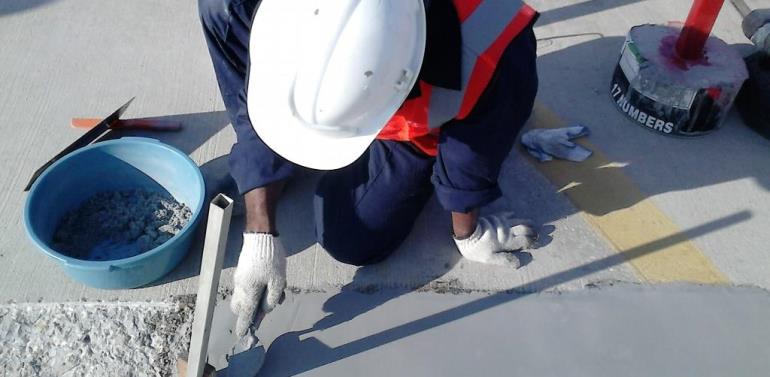International
Saudi Aramco Airport cut costs with cutting-edge polymer repair systems

400 metric tonnes (450 US tons) of aluminium, steel and carbon fibre repeatedly driving across floor areas, approximately 270 times a day, had left 150m (492ft) of concrete floor and expansion joints at a Saudi Aramco Airport in urgent need of repair.
The deteriorated areas, situated in 40 different locations including aircraft taxiways and ramps, were exhibiting severe signs of wear and damage. The concrete had become cracked and spalled and the previous expansion joint sealant had peeled away from the edges of the joint. Due to the high turnover of aircraft, it was imperative that the repair solution incurred as minimal downtime and disruption as possible, ensuring it would not impact on the day-to-day running of the airport.
Field trial confirms flexibility and durability of polymer systems
Following an inspection by Belzona representatives, Bobby Satheesh, QA/QC Manager at Hajjan Trading & Industrial Services Co. Ltd. (Belzona authorised Distributor in Saudi Arabia) specified a solution. He said, “In order to give the airport complete confidence in the Belzona materials, we conducted a sample application to demonstrate the flexible and robust properties of the Belzona systems.” A number of concrete areas were rebuilt with Belzona 4111 (Magma Quartz) and the expansion joints were repaired with Belzona 2221 (MP Fluid Elastomer). The two component epoxy resin system, Belzona 4111, contains selected quartz particles to create an extremely durable rebuilding material with a compressive strength (when tested in accordance with ASTM D695) of 92.7 MPa (13,450 psi). As the material is stronger than concrete, the substrate is able to withstand heavy loading without fear of degradation. Prior to the application of this material, surfaces were firstly coated with Belzona 4911 (Magma TX Conditioner) to ensure maximum adhesion was achieved.
For the expansion joints, Belzona 2221, a tough polyurethane resin with outstanding flexible properties was applied. This material will accommodate high levels of movement and enable the expansion joints to successfully absorb any shock or impact and return to their original shape undamaged. Belzona 2921 (Elastomer GP Conditioner) was applied prior to this system in order to ensure an effective molecular bond with the concrete substrate. The sample application took 18 labour hours to complete and was left to cure for three days. In order to assess its performance, fork-lift trucks were then driven over the repaired areas. As the combination of epoxy and polyurethane systems successfully withstood these loads, the airport decided to continue with the application to the complete 150 linear meters (492ft) of damaged area.
Cold and fast curing systems enable rapid, simple and safe application procedure
Firstly, the concrete was prepared to reveal a sound substrate. Any old coating or previous patch repairs were fully removed. Loose contamination was brushed away and the substrate was then cleaned using Belzona 9111 (Cleaner Degreaser). The surface was then conditioned using two coats of Belzona 4911. Where the concrete edges or nosings were damaged, timber battens wrapped in polyethylene sheets were installed before direct application of Belzona 4111 using a trowel. The material was then tamped down firmly so as to ensure maximum contact with the surface.
For the expansion joints, any loose contamination was brushed away and the substrate was cleaned using Belzona 9111 to remove any dirt, oil and grease. Where the elastomer was to be applied directly onto Belzona 4111, the Belzona 4111 was slightly abraded using emery paper. Belzona 2921 was then applied in two coats to condition the surface. A foam backer rod with a diameter of approximately 20% greater than the width of the joint was installed. Where the depth was greater than 4cm with no support below, filler boards were placed to control the application depth. The Belzona 2221 was applied using a simple pouring technique at a nominal thickness of 1cm (0.4 in), and the system was left to cure.
Quick application procedure keeps airport running smoothly
The extensive repair work was completed over a period of 126 days. The extremely quick cure time of the Belzona systems, (just 2-3 days instead of the 28 days required had the repairs been carried out using concrete) enabled over 40 areas suffering from various degrees of damage to be fixed with no hindrance to the airport operations. Furthermore, as the simple, cold-curing application procedure required minimal equipment during the installation, this meant that the application could be easily rescheduled to the night time, when the day time temperatures reached a scorching 55°C (131°F). Thoroughly satisfied with the material’s performance and the simple application procedure, the airport commissioned an additional 50 linear meters of damaged area to also be repaired by the Belzona systems.
-

 Banking & Finance2 weeks ago
Banking & Finance2 weeks agoOman Oil Marketing Company Concludes Its Annual Health, Safety, Environment, and Quality Week, Reaffirming People and Safety as a Top Priority
-

 Economy2 months ago
Economy2 months agoMaal Card: What Oman’s New National Payment Card Means for Everyday Users
-

 Leaders Speak2 months ago
Leaders Speak2 months agoDhofar International Development and Investment Company: Driving Sustainable Growth and Strategic Synergies in Oman’s Investment Landscape
-

 Events2 months ago
Events2 months agoOER Corporate Excellence Awards 2025 Honours Entities and Innovations in Oman
-

 News2 months ago
News2 months agoSheikh Suhail Bahwan, Chairman of Suhail Bahwan Group, Passes Away
-

 News1 month ago
News1 month agoOIG Appoints New CEO to Lead Its Next Chapter of Excellence
-

 Economy2 months ago
Economy2 months agoOman Unveils Official Omani Rial Symbol in Landmark Move to Boost Global Currency Presence
-

 News1 month ago
News1 month agoReport: How India & The Middle East Are Exploiting Immense Economic Synergies




























You must be logged in to post a comment Login